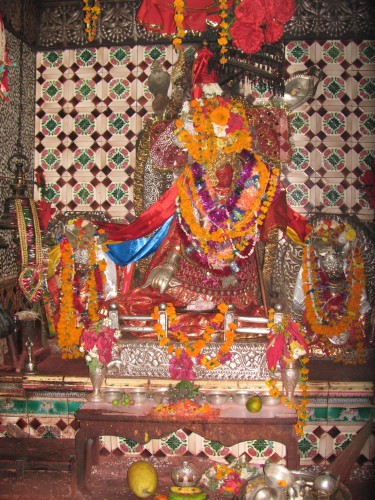The Pamthingpa Brothers
24 Mar
According to Tsem Rinpoche, the Pamthingpa brothers are the students of Naropa and the lineage holders of Vajrayogini Tantras after Naropa. Their name Pamthingpa is not really their’s but rather the name of the place where they reside, which is Pharping. I visited this place several times over the years to pay homage to the Indra Kacho statue of Vajrayogini enshrined within this temple (picture above). I scoured the Internet for information regarding the Pamthingpa brothers. Here is what I found…
—–
From http://ganachakra.com/2010/10/30/naro-khachoma-naropas-space-lady/
Naropa passed the practice of Naro Khachoma to the Pamthingpa brothers (Vagisvarakirti and Bodhibhadra) who after spending years studying and practicing with Naropa, brought the teachings back to Nepal. According to Glenn H. Mullin the Pamthingpa brothers spent years in retreat in their hermitage in Parping, a very important site to Vajrayogini practice.
Eventually the Pamtingpa brothers eventually ended up teaching Melgyo Lotsawa Lotro Drakpa, an early Sakya translator/practitioner and teacher of the great Sakya teacher Kunga Nyinpo. In this way Naro Khachoma practice was included within the Sakya lineage, and later worked its way into the Gelugpa lineage. Naro Khachoma, or Naropa’s Space Lady, is still a very highly regarded practice within these two lineages; a practice that is profoundly powerful in its effacacy of transmuting one’s experience of ordinary being into that of the blissful immediacy of Vajrayogini and her consort Heruka Chakrasmvara.
A rare portrait of the Pamthingpa Yogini (Indra Kechari) in the Pharping temple above. She is an image of the heart-vision of Phamtingpa.
According to Keith Dowman:
This great yogin of the Guhyasamaja, Sambara and Hevajra traditions was the spiritual son of Naropa who may have spent some time in the Kathmandu Valley.
Pham-thing-pa lived in the 11th century and was renowned as one of the great teachers of his day. He studied under Naropa for nine years, receiving the transmission of the Sambara and Hevajra-tantras amongst others. His brother Dus-‘khorba studied under Naropa for five years and his youngest brother Thang-chung-pa was also a practising tantrika. [BA] Roerich adds that Pham-thing-pa was also known as Vagisvarakirti (Ngag-gi dbang-phyug grags-pa); that his remains are said to be preserved at Lo-chia-t’un in Kan-su where he died on his return from the Five Peaked Mountain Paradise of Manjusri (Wut’ai shan); and that pilgrims visit the village of Phambi (Pharping) near Kathmandu where descendants of Pham-thing-pa live.
Extracted from Taranatha’s History of Buddhism in India (Translated by Lama Chimpa & Alaka Chattopadhyaya)
Now about the western door-keeper scholar Acarya Vagishvarakirti. Born in Varanasi, he was by caste a Ksatriya and was ordained in the sect of the Mahasamghika. He received the name Silakirti from the updhyaya. When he became a profound pandita in grammar, logic and in many other sastra-s, he received the Cakrasamvara from one Hasavajra, a follower of Jayabhadra of Konkana. While meditating somewhere in Magadha, he received in his dream his (Cakrasamvara’s) vision. He examined the prospect of attaining siddhi in Vagisvara-sadhana and found the answer in the affirmative.
He meditated on the bank of the Ganga and dropped a red Karavira flower into the Ganga, which emanated sound and illumination. In the moment it was carried away many yojana-s afar and floated back again. He swallowed it up with the water and became a great siddha of Vagisvara. He came to be called Vagishvarakirti as a result of acquiring the intelligence by which he could completely master everyday the words and imports of a sastra containing a thousand sloka-s. He became a vast scholar of the sutra-s, tantra-s and all the other branches of knowledge and he found no difficulty in the three, namely exposition, disputation and composition.
(missing text in between)
He could make the water boil by concentrating for a moment on it. When he consecrated (literally infused life : pranapratistha) an image, it used to move. Once he drew up a mandala for the sake of the king. A devastating flood came near the mandala. As he protected it with his concentration, the flood receded from its fringe. He showed many miraculous feats like these on different occasions.
He was once having a discussion on the Doctrine with a bhiksu called Avadhuti-pa. When he (Avadhuti) quoted Vasubandhu, he (Vagisvara) made sarcastic remarks on the use of corrupt (apabhramsa) words by Vasubandhu. In the same night his tongue swelled and he became incapable of preaching the Doctrine. He suffered from this for several months and on praying to Tara was told : ‘This is the result of your disparaging remarks on acarya Vasubandhu. Therefore, compose stuti-s for this acarya.’ Accordingly, as soon as he composed the stuti, he was cured of the disease.
A thangka of Vasubandu, who was one of the great Indian Buddhist masters and along with his half-brother Asanga, one of the main founders of the Indian Yogacara school.
He then worked in Vikramasila for the welfare of all living beings for many years. In the latter part of his life, he went to Nepal. He remained mostly in meditation there, though he preached a little of the Tantra-yana. But he preached hardly any other aspect of the Doctrine. As he had many consorts most of the people thought that he was incapable of maintaining the conduct of a monk.
The king once built a temple of Cakrasamvara in Santapuri. After its consecration, he got many Tantrikas to assemble outside the temple for holding a big gana-cakra. He sent a messenger to the acarya, inviting him to act as the chief (of the ganacakra). There was a voluptuous dancing girl at the entrance of the cottage of the acarya. There was also a black and violent woman. When (the messenger) asked, ‘Where is the acarya?’, they said ‘He is inside the cottage.’ Then he entered the cottage and said, ‘The king requests you to come and act as the chief of the gana-cakra.’
‘Go back quickly. I shall soon be there.’ As he (the messenger) was returning quickly, the acarya along with his two consorts had already reached the cross-road near Santapuri and said, ‘We are waiting for you for a long time.’
When the main consecration followed by the big gana-cakra came to its end, there remained within the temple only three, i.e. the acarya and his two consorts. He entered the temple with more than the share for sixty-participants of the gana-cakra. The king thought : ‘ There are only three within the temple. What then could be the use for so much provisions of the gana-cakra !’ So he peeped through the door and saw sixty-two deities of Cakrasamvara-mandala sitting there and enjoying the provisions of the gana-cakra.
The 62-deity mandala of Heruka Cakrasamvara, the main practice of Vagishavarakirti that he often had visions of and developed his spiritual realisation with this practice.
In the same place also sat the acarya who had attained the rainbow body. In he Tibetan account, Vagisvarakirti is said to have been the southern door-keeper and Prajnakara the western door-keeper. What I have written here is based on a consensus of three Indian sources. The northern door-keeper was Naro-pa. His account is to be found elsewhere.









Thank you for its informative post